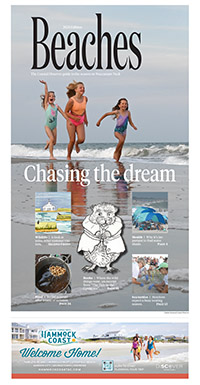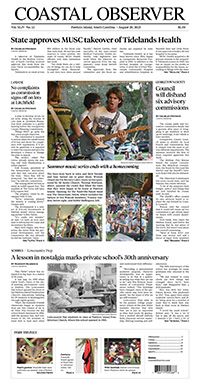Pawleys Island
Town considers a plan for parking

The town of Pawleys Island may not be able to create more parking, but it could make it safer and less frustrating for property owners and visitors. That’s why members of the Planning Commission want to address it in their update of the town’s comprehensive plan.
“It’s critical to have a true parking plan for the island,” Administrator Dan Newquist said.
He recommended it be included as a goal in the 10-year update of the plan, which state law requires local governments to adopt and maintain.
Driving past Huntington Beach State Park one weekday, commission member Robert Moser saw signs on Highway 17 that said the parking lots were full.
“Can we get to full status?” he asked, and if so he wondered how the town would let people know.
Police use social media to provide updates, Newquist said, but the plan could include a recommendation to provide real-time information about available parking.
“In this tech era, there’s probably some kind of software we can tap into,” Town Clerk Daniel O’Hara said, suggesting parking spots could be assigned QR codes.
“A lot of people would just like to know if it’s crazy over here,” commission member Mark Hawn said.
Commission member Ed Fox suggested the town consider limiting the time people can park. He sees people come equipped to spend a whole day at the beach. “That consumes a lot of parking,” he said.
The town raised its permit fee for golf carts this year from $10 to $25. “I don’t understand why the fee isn’t $100,” Moser said, adding that would limit the number of carts. “I don’t think you’re going to approach solving the problem by just telling people don’t come.”
Fox agreed. Even if there is no parking available, drivers circle the island until a space becomes vacant.
“That’s a safety issue,” he said. “You can’t even get a fire truck down the road.”
While public parking makes portions of the island eligible for state and federal funds for beach renourishment – another goal in the comprehensive plan – the town is also responsible for safety, Moser said.
“The parkers on the north end get very aggressive as far as where they can park,” he said. With people opening vehicle doors and kids running between vehicles, “somebody’s going to get hurt.”
The town could consider limiting roadside parking to golf carts, commission member Fran Green said. “That would potentially help the safety issue.”
Newquist also noted that the town lost some of the timbers that are used to define parking spaces during Hurricane Ian. He is reluctant to have them replaced because they become a hazard when they float free during a storm. But the town needs to better mark parking spaces, he said.
A parking plan would fit in with the goals of the community facilities element of the comprehensive plan. It could also be part of the transportation element, Newquist said.
One goal for transportation is to make roads friendly for pedestrians and cyclists.
Fox would like to replace the portable crosswalk markers with painted markers. “The crosswalk signs, to me, are a safety hazard,” he said. The one at Shell Road “is constantly getting run over.”
People walking in the middle of the road is also a concern, Moser said. “I don’t think they should be allowed to obstruct traffic,” he said. “Maybe it’s time for sidewalks.”
However, that could reduce parking.
“People would still be out in the middle of the road,” said John Hildreth, who chairs the commission. “It’s Pawleys Island.”




